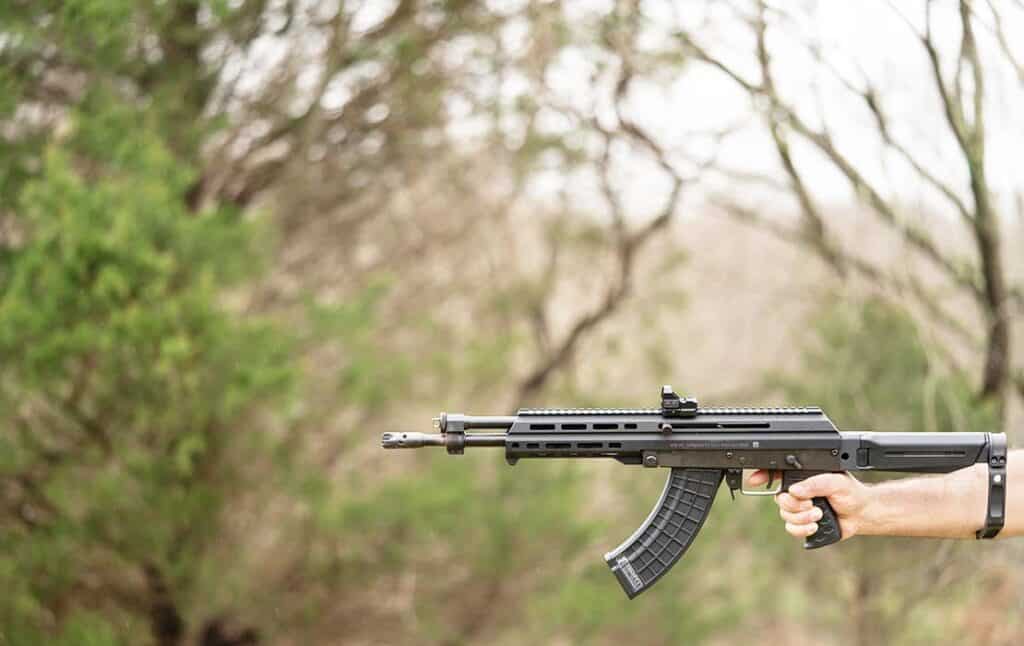By Oleg Volk
A rifle-caliber, semi-automatic pistol is an ugly artifact of the 1934 National Firearms Act which classifies short-barreled rifles as “restricted items” and are heavily taxed. Thanks to inflation, the $200 excise tax which once far exceeding the value of most rifles, is no longer the great deterrent to ownership. The year-long paperwork rigmarole imposed by BATFE, and the restrictions on travel with such rifles gave rise to firearms like the M+M Industries M10x pistol: a stock-less, semi-auto weapon with either a sling or an arm brace to steady it during firing. With the 12.5 inch barrel, the M10x pistol still makes most of the 7.62×39 Russian ballistics without excessive muzzle flash typical of 5.56mm handguns.
For the fans of the M10x design which makes for a highly accurate and reliable modular rifle, turning it into an SBR for improved portability, and potential one-hand use was the next obvious step. With SBR sales depressed by the regulatory impositions, the pistol sales took off smartly. The M10x shares almost all of the same components as its rifle counterpart, but features a shorter barrel, as well as a monolithic upper rail; it is, of course, missing the Magpul ZHUKOV stock.

The gas system is adjustable, with Regular (1), Adverse Conditions (2), Suppressor (regulator turned 180 degrees), and No Gas (0) settings. Its long-stroke piston is a separate part from the bolt carrier, but the two join while in use, with the charging handle as the connector. Its receiver is a modestly sized, forged, and machined part hidden deep within the lightweight aluminum upper. Overall, the pistol with its 12.5-inch barrel shaves off over a pound from the M10x rifle with its 16.5-inch barrel.
Its reduced weight makes it possible to fire the pistol without a two-handed hold, with a rear-attached sling used to stabilize it before firing. An aluminum Tailhook brace, reversible for left- or right-hand use, adds stability both before the shot is taken, and while the pistol cycles. The pistol has minimal muzzle rise, and the flash from the shorter barrel is effectively mitigated by a specially designed flash hider/compensator.


The size of the pistol helps it to perform well in concealed-draw scenarios without sacrificing performance. Fired from a sandbag at 50 yards, the M10X pistol overlapped hits on steel with GECO ammunition and was inside of two inches with generic Comblock surplus. Accuracy testing was done with M+M’s own mini red-dot sight. The optic performed well and added little weight to the handgun. Velocity loss relative to 16.5in barrel was in the 120-150fps range. In other words, while a fight-stopping 125-grain bullet from .357Mag revolver might reach 1500fps, and from carbine a little over 2000fps, this pistol launches bullets of similar weight, with better a ballistic coefficient at 2150fps to 2250fps, depending on the load. With hunting ammunition, such as the highly accurate Federal Fusion soft points, this provides both penetration and expansion for either defense or deer hunting.


The ergonomics of the M10x pistol are quite nice: it features a reversible charging handle, a 45-degree ambidextrous safety, an M-LOK forend suitable for lights and lasers, and a full-length monolithic Picatinny rail on top for red dot sights. Field-stripping the pistol is easy: simply push the take-down lever on the back of the receiver to pivot the hinged upper away from the lower, unlock and remove the charging handle from the bolt carrier, slide the bolt carrier back out of the receiver. The gas piston is retained by the gas regulator and comes out of the front along with the un-tensioned recoil spring. That’s right: no springs fly out of this gun during field-stripping, and no force is required to reassemble it. With the entire recoil system contained within the upper, the rifle version can enjoy a folding stock, while the pistol version requires no buffer tube for functioning. A short tube may be added as an option for the brace. M+M recommends the Gear Head Works Tailhook pistol brace, but others are also compatible. The gun has an unusually low parts count at right around 40.


I have enjoyed superb reliability with M10x rifles, but the pistols have to pass a harsher test. The weapon is less supported during recoil as its shorter barrel requires a bigger gas port with the speeding up of the bolt and carrier during the cycle. During the entire 280-round test conducted at the worst of the ammunition drought, we’ve experienced no malfunctions at all. The bolt didn’t get very dirty, and no flame from the ejection port was visible. The latter is a typical problem with short rifles and rifle-caliber pistols.
Why would someone get a pistol rather than a slightly longer and heavier rifle? In many states, carrying a handgun, no matter what caliber or configuration, is legal. The laws are often less permissive with long guns. While the bark of the short barrel is a mild annoyance at the range, it can help clear some space in a close-quarters counter-ambush. With the brace over the forearm, even a 75-round drum can be supported steadily enough for 50-yard hits. The M+M M10x barrel is well ventilated and properly fenced to avoid burning the support hand. The pistol has a heat endurance of around 100 rounds fired continuously, so a drum and a spare box magazine can be expended without delay. Compared to AK pistols, it recoils more in a straight line, and stays on target better.
This article first appeared in Small Arms Review V25N6 (Jun – July 2021)












